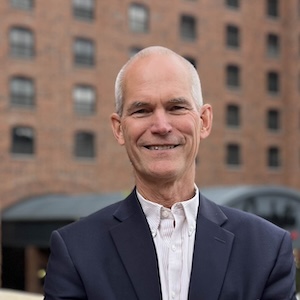Cale Nordmeyer
“I’ve always loved the microscopic world. I don’t know how you can go out in nature and not be enthralled by the diversity that exists all around us. Especially once you identify the things that were common once and now are not there. How can you not think about that?”
Cale Nordmeyer, Master of Biological Sciences (MBS) student, has been thinking a lot about that. In particular, he’s concerned about the future of the Dakota skipper and Poweshiek skipperling butterflies.
“We’ve lost almost all our prairies,” he continues. “The same thing that’s happening with the rainforests is happening right in our backyards. About one-third of Minnesota used to be tall grass prairies; now it’s 1%. And we’re losing what used to live in those ecosystems, too.”
“They may look like moths, but technically, they’re butterflies.”
The Dakota skipper is a small, brown to golden butterfly with a thick body, clubbed antennae, and large dark eyes. The Poweshiek skipperling is dark brown on its upperside with orange along the edges. The underside of its hindwings are dark grey with white veins. As caterpillars, both species eat native prairie grasses.
Once predictable and widespread in Minnesota, possibly only one Dakota skipper population is left here, he says. Some exist on privately owned land but are difficult to gain access to. Poweshiek skipperlings are likely gone from the state altogether. In 2014, both species were listed as Federally Threatened and Endangered, respectively.
“There’s so much to study, and I feel pressure to learn all I can because we’re losing them,” Nordmeyer says. “My main goal is to become a better researcher in order to conserve these butterflies. That’s why I went back to school. I want to make sure I’m the right person for the job.”
The Problem with Skippers
His primary focus as butterfly conservationist at the zoo is to investigate why the Dakota skipper and Poweshiek skipperling numbers are declining, even in habitats that are protected. He is considering a few possibilities:
- Isolation of the remaining prairies. The Dakota skipper only has a wingspan of 1.5 inches and therefore can’t travel long distances, even to the next prairie down the road, if one even exists.
- Impact of new classes of pesticides on the ecological landscape
- Genetics: because of the small, solitary populations, the rate of in breeding could be high.
- Climate change: skippers have anti-freezing agents in their bodies and can survive the Midwest winters. What is the effect of having little or no protective snow pack during hibernation?
On top of this, collecting data on these species is difficult. The adults are only active for three weeks, and that time can vary each year. The caterpillars are almost impossible to detect, as they attach themselves to the base of blades of grass. When adult Dakota skippers hatch, they measure “about the size of Lincoln’s nose on a penny.” Before they become a chrysalis, they are only an inch or so long.
Furthermore, if you remove too many adults from a habitat, you risk decreasing the overall population. You could rescue all of them, like the US did with the California condor, or take a small sample knowing it might impact the total numbers.
The Road to Replenishment
Nordmeyer and Erik Runquist, the prairie butterfly conservation project manager at the Minnesota Zoo, now face the challenge of restocking the diminished populations. In 2013 the team collected their first Dakota skipper eggs to be raised at the Zoo, and had an acceptable rate of survivorship.
This is the first large scale-breeding program for the Dakota skipper, or similar species, and completely uncharted territory. Very little is known about the Dakota skipper’s natural history, and much of Nordmeyer’s research is studying what host grasses the caterpillars prefer and how they interact with their environment.
"What would it take to encourage the adult butterflies to breed?"
The answer lies in developing specific husbandry techniques. The process is more complicated than just placing a male and a female together in a cage, though. “Dakota skippers have unique rituals,” Nordmeyer says. “What seems to work is to put a bunch of males together first and have them display competitive behaviors. Then when the female is introduced, the males are suddenly interested.”
This type of mating ritual, where a group of males puts on competitive displays and the female selects one, is called lekking and knowing about it increases the chances of breeding success.
But there is still progress to be made. This summer Nordmeyer and Runquist will be expanding the program and collecting Poweshiek skipperling eggs in Michigan to raise as caterpillars at the Zoo then release in the wild. “We probably won’t keep them indefinitely… The goal is not to just keep a bunch of butterflies in a basement somewhere, but to help get them back out in the landscape.”
“Wait a minute, you can study this stuff?”
In high school, it wasn’t obvious to Nordmeyer that biology was a field you could go into as a career. He loved working and creating with his hands and was content with the idea of becoming a starving artist. Then an art instructor, who noticed that his pieces were always highly detailed and analytical, suggested he look into biological illustration, which opened a door to the natural world he hadn’t considered before. “I was a biologist all along, I just didn’t know it.”
Later, at Lewis and Clark College in Oregon, he majored in biology and participated in labs with brown recluse spiders, sea slugs, and the Oregon silver spotted butterfly. It was here where his childhood love of insects and all things small spurred his interest in research, particularly in captive insect breeding.
During a summer internship at the Minnesota Zoo, they offered him a paid position as lead naturalist and he accepted, thinking he would move on once he figured out what he wanted to do permanently. But he fell in love with zookeeping, working with birds and in the butterfly garden, where he could “foster animal connections” with future generations.
Nordmeyer acknowledges that some people may have negative opinions about zoos, but many—like the Minnesota Zoo—have expanded their missions to include “science, conservation, and research. And for many species, they become modern day arks, because there is no other wild habitat for them to live in. We have to create it.”
Taking Flight
Nordmeyer plans to graduate in spring 2017. For now, he still works full time at the zoo and manages to take two classes a semester. And while he can’t predict whether or not the Dakota skipper and Poweshiek breeds will ever flourish again, his motivation is steadfast.
“They’re not sexy or the most striking butterflies to look at. So what if they go extinct, who cares?” he says. “My argument is abstract, but I don’t think that matters. Something is wrong in the prairies, and they are the first ones to show it. They’re also part of our heritage and our state’s landscape. It would be a smaller, less diverse Minnesota if they vanish entirely.”
The Dakota skipper breeds just one generation a year, with the adults flying for only three short weeks in the summer. You won’t find Nordmeyer inside an office or a classroom then: he’ll be out on the prairie, tackling big questions by thinking small.









